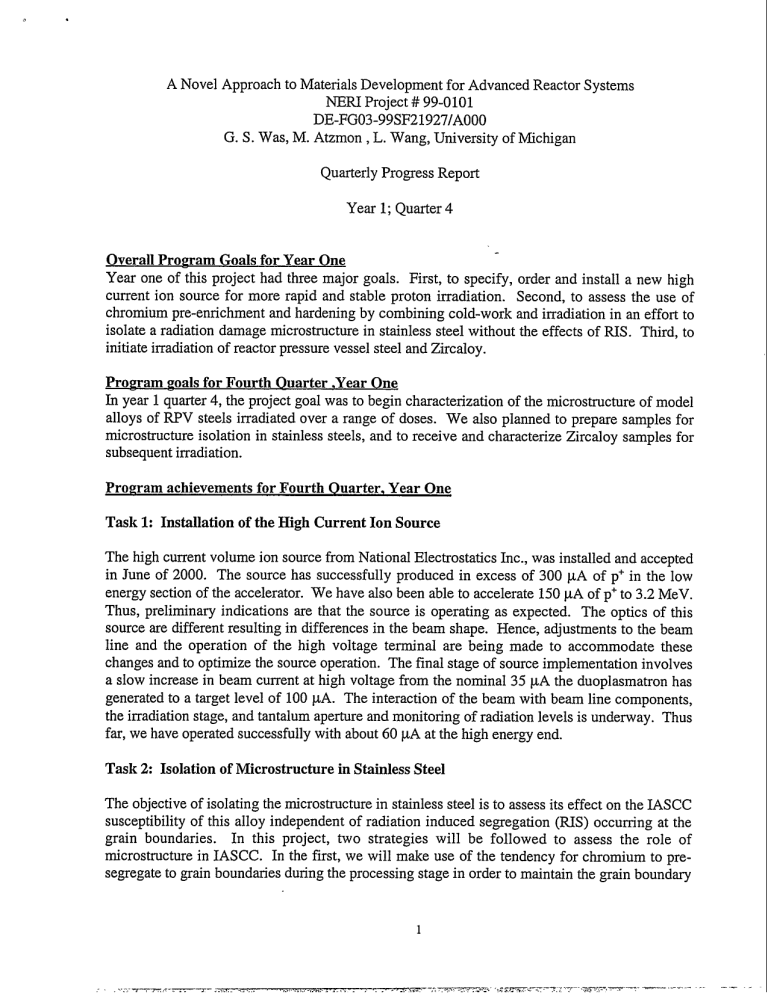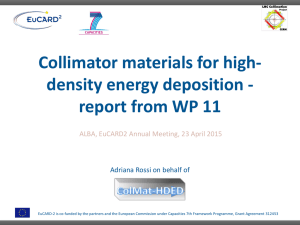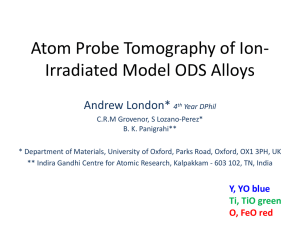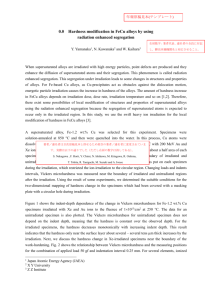
, . A Novel Approach to Materials Development for Advanced Reactor Systems NERI Project # 99-0101 DE-FG03-99SF21927/AOO0 G. S. Was, M. Atzmon , L. Wang, University of Michigan Quarterly Progress Report Year 1; Quarter 4 Overall Program Goals for Year One Year one of this project had three major goals. First, to specify, order and install a new high current ion source for more rapid and stable proton irradiation. Second, to assess the use of chromium pre-enrichment and hardening by combining cold-work and irradiation in an effort to isolate a radiation damage microstructure in stainless steel without the effects of RIS. Third, to initiate irradiation of reactor pressure vessel steel and Zircaloy. Program peals for Fourth Ouarter .Year One In year 1 quarter 4, the project goal was to begin characterization of the microstructure of model alloys of RPV steels irradiated over a range of doses. We also planned to prepare samples for microstructure isolation in stainless steels, and to receive and characterize Zircaloy samples for subsequent irradiation. Prowam achievements Task 1: Installation for Fourth Ouarter, Year One of the High Current Ion Source The high current volume ion source from National Electrostatics Inc., was installed and accepted in June of 2000. The source has successfully produced in excess of 300 VA of p+in the low energy section of the accelerator. We have also been able to accelerate 150 WA of p+to 3.2 MeV. Thus, preliminary indications are that the source is operating as expected. The optics of this source are different resulting in differences in the beam shape. Hence, adjustments to the beam line and the operation of the high voltage terminal are being made to accommodate these changes and to optimize the source operation. The final stage of source implementation involves a slow increase in beam current at high voltage from the nominal 35 pA the duoplasmatron has generated to a target level of 100 pA. The interaction of the beam with beam line components, the irradiation stage, and tantalum aperture and monitoring of radiation levels is underway. Thus far, we have operated successfully with about 60 pA at the high energy end. Task 2: Isolation of Microstructure in Stainless Steel The objective of isolating the microstructure in stainless steel is to assess its effect on the IASCC susceptibility of this alloy independent of radiation induced segregation (RIS) occurring at the grain boundaries. In this project, two strategies will be followed to assess the role of microstructure in IASCC. In the first, we will make use of the tendency for chromium to presegregate to grain boundaries during the processing stage in order to maintain the grain boundary 1 ..--—,--—- ..--, -... ... :.-’T -.. ,,rer.zc-.-. -,--r-, --r–- .73-.-.=, -. —--- ~. -.. -- -- ---- - DISCLAIMER This repofi was prepared as an account of work sponsored by an agency of the United States Government. Neither the United States Government nor any agency thereof, nor any of their employees, make any warranty, express or implied, or assumes any legal liability or responsibility for or usefulness of any completeness, the accuracy, information, apparatus, product, or process disclosed, or represents that its use would not infringe privately owned Reference herein to any specific commercial rights. product, process, or service by trade name, trademark, manufacturer, or otherwise does not necessarily constitute or imply its endorsement, recommendation, or favoring by the United States Government or any agency thereof. The views and opinions of authors expressed herein do not necessarily state or reflect those of the United States Government or any agency thereof. DISCLAIMER Portions of this document may be illegible in electronic image products. Images are produced from the best available original document. -—-—rr.*,. -r, ... ,, . . . . . - T..-...-,>. . . . . “wx?7 --. , , >-J. -,... , . ..—$-mT.-. , -: .-..,.,. .Z--.7. --.7 -7---, -..-..-< ----- ,.. .- . . Cr level during subsequent irradiation. While the concentration of other elements at the grain boundary may change (enrich or deplete), the Cr concentration will be designed to remain at or above the nominal level, thus removing chromium depletion from consideration as a factor in the IASCC behavior. The second strategy involves the production of a series of samples of fixed hardness but with varying amounts of radiation damage. This will be accomplished by interchanging cold-work and irradiation dose to achieve the same nominal hardness, but with varying contributions from the two sources of hardening. The objective in this series of experiments is to determine if hardening alone is responsible for IASCC or if IASCC is specifi~ to the nature of hardening. Chromium me-se~re~ation A series of thermal treatments has been conducted on a heat of 304 SS with composition described in Table 1. The heat treatments are given in Table 2 and are designed to result in Cr enrichment at the grain-boundary. The heat treatments are based on the calculations of Simonen et al. [1] who developed a model for thermal non-equilibrium segregation of chromium. In this model, a high temperature anneal produces a high concentration of vacancies. Slow cooling or quenching followed by lower temperature thermal treatment allows for the segregation of chromium to grain boundaries by a vacancy mechanism. The sample conditions given in Table 2 will be analyzed using STEM-EDS and the treatment producing the greatest amount of chromium pre-segregation will be selected for irradiation. On the basis of existing data, [2] it is expected that irradiation to doses up to 3.0 dpa will not cause grain boundary chromium depletion below the bulk level in the alloy. Calculations on chromium depletion using the Perks model for RIS predict much more rapid redistribution of chromium with dose. [3] However, this behavior is not observed in practice and doses in excess of 3.0 dpa are required to cause chromium depletion. While the reason for the sluggish depletion of pre-segregated chromium is not well understood, the behavior presents an opportunity to achieve irradiation doses well into the regime where IASCC is observed to occur, without altering the grain boundary chromium composition significantly from the bulk level. In this way, we can focus on the microstructure as the potential cause of IASCC. STEM-EDS analysis of grain boundary Cr enrichment will be characterized next, followed by irradiation and then characterization of the resulting RIS. Hardening and the irradiated microstructure Table 3 gives the hardness of cold-worked316SS as a function of the amount of cold work. The figures in bold are actual measurements and the remaining numbers are estimations by interpolation of the known data. The hardness caused by 50% CW is fixed as the nominal value for all samples and the difference between the nominal value and that at lower levels of cold work will be compensated by irradiation to various doses. Column 4 gives the expected irradiation dose at 360°C (protons) required to achieve a constant hardness for the value of cold work given in column 3. Again, the numbers in bold are measured values and the other figures are interpolations. As shown, irradiation to doses up to 3.0 dpa of a previously cold-worked structure should produce a constant hardness. The total hardness and the fraction of the hardness REWIWED 2 SEP28 20!0 OSTI . accounted for by radiation damage is shown in Figure 1. The success of this strategy depends on the preservation of the cold-worked structure during irradiation. It is known that irradiation of cold-worked materials under fast-reactor conditions results in an elimination of cold work at high doses. It is expected that some removal of the cold-worked micros~cture will occur in 360”C irradiations. However, the low dose and low temperature compared to the fast-reactor conditions should minimize the annealing of the cold-worked structure during irradiation. The next step is to conduct irradiations of samples with various levels of cold-work and measure the total hardness to determine if a fixed nominal hardness can be maintained, by varying the contributions from cold-work and from irradiation. Task 3: Samples for Zircaloy Irradiation Three types of Zircaloy samples were prepared for shipment by Dr. James Dougherty at Western Zirconium, Zircaloy 2, Zircaloy 4 and ZIRLO (containing Fe, Sn and Nb). They are due at the University of Michigan at the end of September 2000. Table 4 contains their respective compositions. Their nominal thickness is 0.025”. If the samples are not sufficiently rigid to allow adequate heat sinking on the irradiation stage, design modification will be carried out to allow mounting shorter samples. Table 5 contains information on typical mechanical properties at room and elevated temperature, as well as texture and second-phase particle sizes for the Zircaloy batches to be used. The parameter f(x) is a measure of the volume fraction of the alloy with basal planes aligned in the direction x, where 1, t and n represent longitudinal, transverse and normal. Preliminary TEM characterization of Zr samples has been conducted in order to establish the sample preparation and analysis methods. . Task 4: Proton Irradiation of Model RPV Steels No additional irradiations were conducted in this quarter. Work was focused on the analysis of the irradiated microstructure using small angle x-ray scattering (SAXS) and TEM. Microstructure investigation usinszSAXS Microstructure characterization of the irradiated alloys will be done using both high resolution transmission electron microscopy (HRTEM) and small angle x-ray scattering (XSAS). As a first step in characterizing the microstructure, we began sample preparation and initial analysis of the unirradiated and irradiated samples with SAXS with the help of Dale Alexander at Argonne National Laboratory. SAXS is an ideal technique for studying structural features of colloidal size (tens to hundreds of nm) particles. It provides a complementary capability to “microscopic” techniques such as atom probe/field ion microscopy and electron microscopy for characterizing the very fine embrittled microstructure present in irradiated reactor pressure vessel materials. The information obtainable from SAXS includes size distribution, number density and volume fraction of particles, all important features that are key to understanding the mechanistic hardening process in embrittlement. Anomalous small angle x-ray scattering was conducted on the SAXS beam line at the Advanced Photon Source (APS) at a photon energy of 7.09 keV. The 3 schematic of the ASAXS instrument is shown in Figure 2. The sample preparation procedure follows. Samples of alloy VD irradiated to 0.01 dpa and to 0.001 dpa and unicradiated counterparts were prepared for SAXS. Sample preparation proceeded as follows: Samples were ground on the unirradiated side of the bar up to a thickness of 250 microns. The bar was then cut into 3 mm diameter disks by core-drilling. Two disks were cut from each bar; one was cut at the center of the bar (irradiated region), and the other was cut at the edge of the bar (unirradiated region/control sample). The irradiated side was lightly polished with fine grit (3 pm A120~) to ensure flatness. Then the sample was electropolished to remove- the cold-worked layer resulting from the polish. Electropolishing was done in a solution of Methanol (500 ml) and butylcellsolve (100 ml) with the addition of 5.3 g of LiCl and 11.6 g of Mg(CIO&. The bath was cooled to –50°C. Electropolishing was conducted at a voltage of 109 V and with currents between 100 and 140 mA for 10 sec. The unirradiated side was ground until the sample thickness was in the range 60-70 microns. A finer grit was used to polish the disk down to a thickness of 30 microns. The unirradiated side was then electropolished in the same solution used for the irradiated side. Samples were stored in alcohol until they were ready for analysis. Analvsis of small arwle x-rav scattering experiment For randomly distributed particles with a simple well-defined shape, of a single size and in a dilute concentration, the angular dependence of the scattered intensity can be calculated. The scattering profile is strongly dependent on the shape and size of a particle. However, Guinier pointed out that at very small angles the angular dependence of the scattering is a universal function of size. From Guinier’s approximation [4]we obtain: (1) where @is the scattering vector which defines the geometry of the experiment. For small angles, 20, the modulus q is 2zWL RGis the particle radius of gyration. Equation (1) can be rewritten as: lnI(q)=K–~q2 (2) From the slope of a plot of lrd(q) vs. q2, we obtain directly the radius of gyration, & and then the particle radius, R=(5/3)lnR~ (assuming spherical particles). Phythian [5] confirmed the spherical symmetry of the strain field around the precipitates in Fe-1 .3CUmodel alloy through TEM. The relation between q and 1 is shown in Figure 3. Samples at both dose levels, 0.001 dpa and 0.01 dpa, produced higher scattering intensity than the unirradiated controls. The 0.01 dpa sample has stronger intensity than the 0.001 dpa sample, indicating a higher density or larger size scattering centers. At the same time, the intensity of the 0.01 dpa dose sample drops as q increases, approaching the curve for the unirradiated sample at high q values and angles. With the angle of X-ray scattering increasing, the upper limit of the structure size, which the scattering reflects, will decrease. At large angles, X-ray scattering is not sensitive for larger structures. At the lower size limit, the scatte@g off of lattice atoms is no different between an irradiated and an 4 unirradiated sample, so the corresponding curves approach each other. We also note that the curve for the 0.001 dpa sample does not approach that for the unirradiated sample at high q. This is likely due to contamination from Kapton tape used in the experiment. Kapton tape is used to suspend the foil samples in the X-ray beam. Unfortunately, our current setup resulted in slippage of a stepper motor, resulting in rnis-positioning of the sample in the beam. In the low dose proton case, some of the kapton tape was intercepted and scattering from it was superimposed upon the sample signal. The relation between lnl (where I represents the difference between the irradiated and the unirradiated signals) and ~ is shown in Figure 4. For both dos~s, we obtain excellent linear fits to the data. From eqn. (2), the precipitate radius in the 0.001 dpa dose sample is about 7.1 & and in the 0.01 dpa dose sample it is 16.0 & The low dose size is smaller than that resulting from electron irradiation, [6] 11.8 ~ (VD, 0.0005dpa, 7.5x10-9dpa/s, 300”C). However, the high dose precipitate size is close to that following neutron irradiation to -0.013 dpa (1.8 nm for a l-feature fit and 1.0 and 2.0 nm for a 2-feature fit). [7] It should be noted that the Guinier approximation is strictly valid in the range qRG<d .0. [8] In these measurements, RG is 5.5A for the low dose and 12.4A for the high dose, yielding values of qRG. in the range 0.5 to 1.2. Hence, the approximation is not strictly valid for these data. In future work, the maximum entropy method will be applied to the data. Preliminary TEM results Very preliminary results from TEM have been obtained from the 0.01 dpa VD sample in the as-irradiated condition. Figure 5 shows a diffraction pattern and resulting dark-field image from a thin region of the foil. The diffraction pattern consists of diffraction spots and polycrystal rings. The spot pattern is consistent with (110) bcc iron and originates from the ferrite lattice. The rings could be due to a high density of very small second phase particles. The dark field image to the right results from a portion of the ring pattern. The bright spots in the dark field image giving rise to the diffusion rings may be second phase particles. The average size of the features is -5.2 nm, larger than the SAXS measure of 3.2 nm. Indexing reveals that the particle structure is consistent with a bcc structure. The results are very preliminary and it needs to be verified that the particles are indeed in the sample bulk and do not result from surface contamination (re-precipitation) during electropolishing. References 1. E. P. Simonen and S. M. Bruemmer, Proc. 8ti Int’1 Symp. Environmental Degradation of Materials in Nuclear Power Systems – Water Reactors, American Nuclear Society, La Grange Park, IL, 1997, pp. 751-757. 2. J. T. Busby, J. Gan, M. Daniels, G. S. Was, S. M. Bruemmer, D. J. Edwards and E.A. Kenik, Proc. 9ti Int’1 Conference Environmental Degradation of Materials in Nuclear Power Systems – Water Reactors, NACE International, Houston, TX, in press. 3. J. Busby, unpublished results. 4. Guinier, (1938), Nature 142,569 5. Phythian, W. J., Foreman, A. J. E., et al, “the Structure and hardening Mechanism of Copper Precipitation in Thermally Aged or Irradiated Fe-Cu and Fe-Cu-Ni Model Alloys,” Effects of 5 ,“,:“:,!’. .. Radiation on Material: 15* International Symposium, ASTM STP 1125, Philadelphia, 1992, pp.131-150. 6. Alexander, D. E., Kestel, B. J., et al, “Correlating Radiation Exposure with Embrittlement: Comparative Studies of Electron- and Neutron- Irradiated Pressure Vessel Alloys,” ASTM 1398, West Conshohocken, PA, 2000 7. R.G. Odette, unpublished results. 8. Eric Lifshin, X-ray Characterization of Materials, Wiley-VCH,1999, pp.221. Table 1. Composition of 304 SS used in microstructure experiments (wt%) Cr Ni Mn Mo Si Fe c N P bal. 18.3 8.5 1.38 0.37 0.65 0.068 0.03 0.035 s 0.03 Table 2. Heat treatments for 304 SS to induce non-equilibrium chromium segregation Annealing Cooling Heat Time/temperature temp./ time treatment history history 1100°C/8 min. Air cool HT #1 53 tin to 20”C Water quench 1100°C/8 min. HT#2 Water quench 1100°C/8 min. Furnace cool to HT #3 1100°C to 1000”C in 1000°C + quench 75 min quench to 20°C HT #4 1100°C/8 min. Furnace cool to 1100°C to 900”C in 900°C + quench 190 tin quench to 20°C Table 3. Combinations of cold work and irradiation of 301 SS for constant hardness 0/0 Cw AHvcw Dose I AHJmd H,. AH,TOTM I H.ToTAL I (kg/mm’) 200 200 0 10 200 20 200 200 (kg/mm’) (kg/mm’) (Wt%) (kg/mm’) (dpa) (kg/mm’) 0 3.0 184 184 2.0 0.7 122 43 186 64 145 ] 25116910.3116 -0.9 384 I 386 I -0.2 I 43%+3 216 35 0.0 0 Values in bold are measured, others are interpolations fron measured data. 6 ccrGB Table 4. Average ingot compositions for sample material, obtained from five positions along ingot length. INGOT (alloy) U04805P (ZR-4) U04271L (ZR-2) U04755Z (ZIRLO) Fe (ppm) 2087 1646 939 Sn (%) 1.35 1.29 1.08 Cr (ppm) 1134 1043 -- Ni (ppm) -644 -- Nb (%) .-0.96 Table 5. Properties of Zircaloy sample material. The parameter f(x) is a measure of the volume fraction of the alloy with basal planes aligned in the direction x, where 1,t and n represent longitudinal, transverse and normal. MAJOR ELEMENTS UTSIYSI%E (Icsi) SECONDPHASE PARTICLE SIZE (microns) ALLOY ZR-4 Sn, Fe, Cr 10 ZR-2 Sn, Fe, Cr, Ni 12.5 ZmLo Sn, Nb, Fe 10 L =65/50/ 32% (RT) T =64 152 134% (RT) L=28/ 16/50% (315 “C) T=27/ 17/48% (315 C) L=77/62/32%(RT) T= 72 / 66 / 30% (RT) L =38/ 30/ 50% (288 “C) T = 34/28 /43% (288 ‘C) L=72/57/32%(RT) T=69/62/30%(RT) L=38/ 22/42% (315 “C) T=34/25 /36% (315 “C) UTS – ultimate tensile strength L – longitudinal T – transverse RT – room temperature 7 CRYSTALLOGRAPHIC TEXTURE .20 f(l) = 0.10 f(t) = 0.15 f(n) = 0.75 .06 f(1) = 0.07 f(t) = 0.25 f(n) = 0.68 .06 f(1) = 0.08 f(t) = 0.22 f(n) = 0.70 250 -1- T J- -L n ‘E E sz 200 150 100 50 0 0 0.3 J_ 0.7 L 2 3 Dose (dpa) Figure 1. Estimated superposition of hardening due to cold-work and irradiation. Total change in hardness is calculated assuming that cold-work and irradiation hardening add linearly. The hardness increase due to cold-work and that due to irradiation at 3 dpa are measured, whereas the contribution of irradiation at 0.3 to 2 dpa are estimated. Figure 2. Schematic of the ASAXS instrument. The values given after the components are the distances from the source: 1) Undulator source; 2) horizontal focussing mirror, 33m; 3) Double crystal monochromator, 35m; 4) Source defining slit, 38m; 5) Vertical focussing mirror, 45m; 6) Beam defining slit, 50 m; 7) Ionization chamber, 52 m; 8) Shutter, 52m; 9) Guard slit (round pinhole), 58m; 10) Sample, 58rn, 11) Scattering beam path; 12) Beam stop, 59 to 68m; 13) Detector, 59 to 68m. ..........i~ \ I ‘r———— 0.1 0.01 .....................................................- ................ 0.001 .......................7 ................................ ......... w unirradlated I 0.01 0.001 1 0.1 q (A-’) 0.1 . . . . . . . r ........................................... b ,.. I % .= m g = 0.01 u a g E z z L. i ................................... ., 4 ; 0.001 ........................... ..... unirradiated t ,1 0.001 0.01 I ~ I 0.1 q (A-’) Figure 3. The relation between scattering vector q and X-ray (E=7.090keV) intensity 1 for a)O.001dpa and b)O.01 dpa proton (3.2MeV) irradiation at 300°C for VD alloy (l?e-O.9Cu-l.0). -5.5 I -6 . ........ I I 1 u I I 1 ........................................................................................................... ...... ii! : -6.5 . ............................. y=-6.09@3-l R=O.987~7 0.201 ............................................... %3:3A3’4 ., : : + .. ... ..... ...... Q i q j ~:1 -7 . ...................... ............................... L“......+....... OM1.dna -.---r=7.lr .++ :1 -7.5 ....... %:; ........................................... L................................................................. .m% ~~ f! % :0= : ‘1 ............ . . . . . . . . . ; NY:-+ O.Oldpa -8 ‘ .....-.” .........-...\ .......... r=16.Oii g . .............. , \ri t I -8.5 o 0.01 , , t I , t , 0.02 , I , 0.03 , I I 0.04 0,05 qz (A-2) Figure4. Therelation oflflmd q2forthe ~alloyproton-ina& and 0.001 dpa at 7x10-7dpa/s, and 300”C. atedtodosesof O.Ol Figure 5. (a) Diffraction pattern from 0.01 dpa alloy VD (Fe-0.9Cr-l.0Mn), showing both spot and ring patterns; (b) dark field image produced from a segment of the rings in the diffraction pattern. 12


